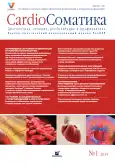Strategy and tactics of emergency treatment of atrial fibrillation: a modern approach to the problem
- Authors: Bunin Y.A1
-
Affiliations:
- Russian Medical Academy of Postgraduate Education of the Ministry of Health of the Russian Federation
- Issue: Vol 6, No 1 (2015)
- Pages: 60-64
- Section: Articles
- URL: https://journals.rcsi.science/2221-7185/article/view/45166
- DOI: https://doi.org/10.26442/CS45166
- ID: 45166
Cite item
Full Text
Abstract
Full Text
##article.viewOnOriginalSite##About the authors
Yu. A Bunin
Russian Medical Academy of Postgraduate Education of the Ministry of Health of the Russian Federation
Email: yabunin@rol.ru
д-р мед. наук, проф. ГБОУ ДПО РМАПО 125993, Russian Federation, Moscow, ul. Barrikadnaia, d. 2/1
References
- Guidelines for the management of atrial fibrillation. Eur Heart J doi: 10.1093 /eurheart/ ehq 278.
- AHA/ACC/HRS Guideline for the management of patients with atrial fibrillation. Http://circ.ahajournals.org/content/early/2014/04/10/CIR.
- Constantini O, Stambler B. Approach to the patients with atrial fibrillation. In Gans L.I, Braunwald E (eds). Management of cardiac arrhythmias. Hymana Press 2004; p. 75-96.
- Khan I.A. Single oral loading dose of propafenonefor pharmacological cardioversion of recent onset atrial fibrillation. J Am Coll Cardiol 2001; 37: 542-7.
- Bunin Yu, Anfalova L. Efficacy of propafenone as single oral loading dose in pharmacology converting recent - onset atrial fibrillation and atrial flutter. Europace 2005; 7 (Suppl. 1): 121-2.
- Chevalier P, Durand-Dubief A, Burri H. Amiodarone versus placebo and class IC drugs cardioversion of recent - onset atrial fibrillation: a meta - analysis. JACC 2003; 41: 255-61.
- Rho R.W, Callans D.J. The management of atrial flutter. In Gans L.I., Braunwald E. (eds). Management of cardiac arrhythmias. Hymana Press 2004; p. 163-82.
- Camm A.J, Capucci A, Hohnloser S et al. A randomized active - controlled study comparing the efficacy and safety of vernacalant to amiodarone in recent onset atrial fibrillation. J Am Coll Cardiol 2010; 4: 134-9.
- Sung R.J, Tan H.L, Karagounis L et al. Intravenous sotalol for the termination of supraventricular tachycardia and atrial fibrillation and flutter. Am Heart J 1995; 129: 739-48.
- ESC guidelines 2011 on management of cardiovascular disease during pregnancy. doi: 10.1093/eurheartj/ehr 218.
- American heart association guidelines for cardiopulmonary resuscitation and emergency cardiovascular care. Circulation 2005; 112: IV1-211.
- Niebauer M.J, Brewer J.E, Clung M.K et al. Comparison of the rectilinear biphasic waveform with monophasic damped sine wave - form for external cardioversion of atrial fibrillation and flutter. Am J Cardiol 2004; 93: 1495-9.
- Ricard P, Vaici K, Rinaldi J.P et al. Cardioversion of atrial fibrillation: how and when? Eur Heart J 2003; 5 (Suppl. H): H40-H44.
- Botto G.L, Politi A, Bonini W et al. External cardioversion of atrial fibrillation: role of paddle position on technical efficacy and energy requirements. Heart 1999; 82: 726-30.
- European heart rhythm association practical guide on the use of new oral anticoagulants in patients with non - valvular atrial fibrillation. Europace 2013; 15: 625-51.
Supplementary files







